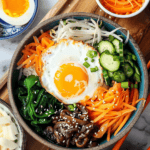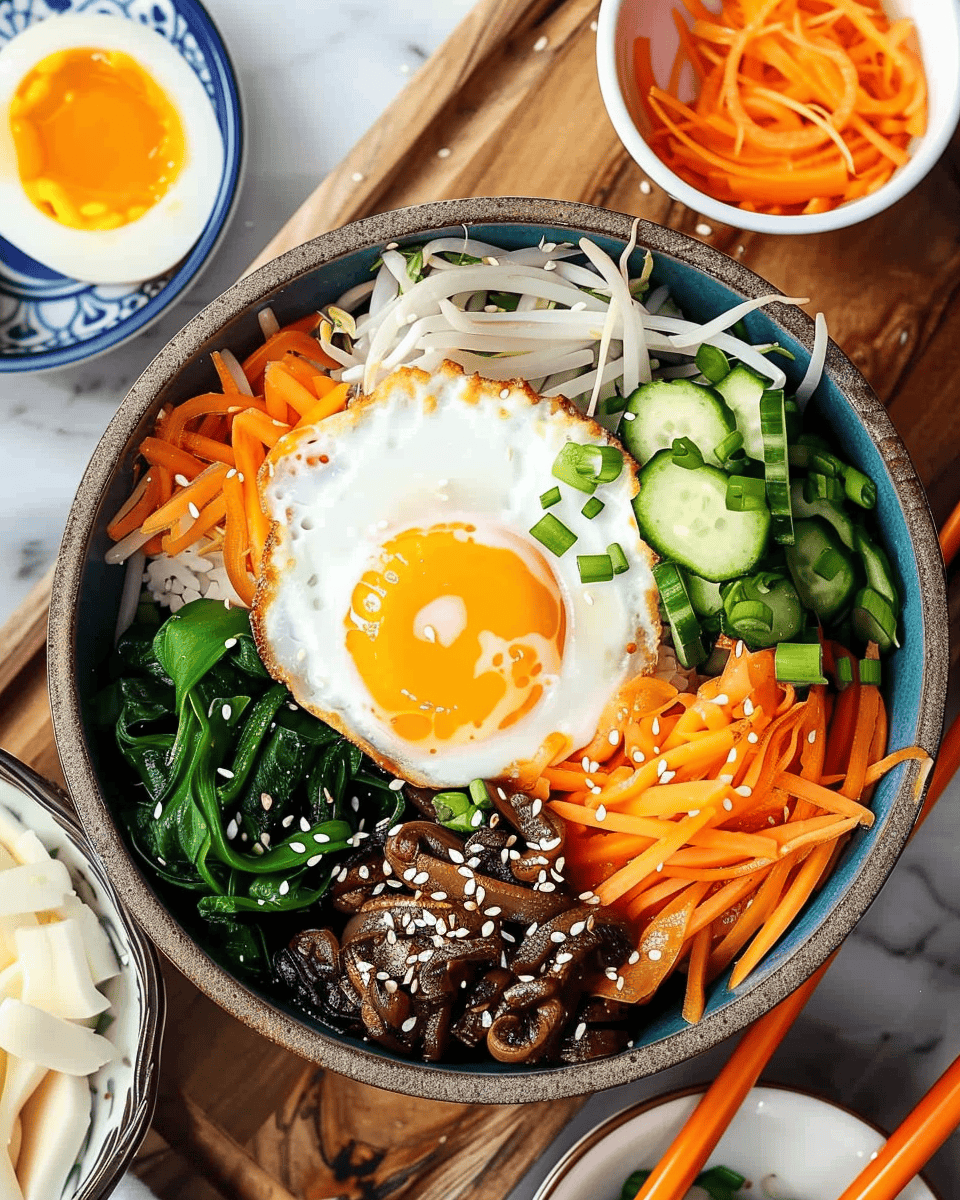Bibimbap: A Colorful and Healthy Korean Rice Bowl
Bibimbap, a classic Korean dish known for its vibrant array of ingredients and delicious flavors, is a delightful meal that combines simplicity with nutrition. This recipe offers a step-by-step guide to creating your own Bibimbap at home, complete with a variety of vegetables and a spicy gochujang sauce. Whether you prefer a vegetarian version or one with a protein boost from eggs or tofu, this dish can be customized to suit your dietary preferences.
Ingredients:
- ½ English cucumber, thinly sliced
- ½ teaspoon rice vinegar
- 1¼ teaspoons toasted sesame oil, divided
- 1 cup fresh mung bean sprouts
- 1 cup shredded carrots
- 4 cups baby spinach
- ½ teaspoon tamari
- 2 cups cooked short-grain white rice
- 2 fried eggs or 1 cup cubed baked tofu
- 4 ounces sautéed shiitake mushrooms (optional)
- Gochujang Sauce (recipe below or store-bought)
- Sesame seeds for garnish
- Sea salt to taste
- Kimchi (optional, for serving)
- Chopped scallions (optional, for serving)
Directions:
- Prepare the Cucumber:
- In a small bowl, combine the cucumber slices with rice vinegar, ¼ teaspoon sesame oil, and a pinch of sea salt. Set aside to marinate.
- Cook Mung Bean Sprouts:
- Bring a small pot of water to a boil. Blanche the mung bean sprouts for 1 minute, then drain and set aside.
- Sauté Carrots:
- In a skillet, heat ½ teaspoon of sesame oil over medium heat. Sauté the shredded carrots with a pinch of salt for 1-2 minutes until slightly softened. Transfer to a dish and set aside.
- Wilt Spinach:
- In the same skillet, add the remaining ½ teaspoon of sesame oil. Add the spinach and tamari, and sauté for about 30 seconds until just wilted. Remove from heat and press out excess moisture.
- Assemble the Bibimbap:
- Spoon cooked rice into bowls as the base. Arrange the prepared cucumber, bean sprouts, carrots, and spinach neatly around the rice.
- Top with a fried egg or baked tofu. Add sautéed shiitake mushrooms if using.
- Sprinkle with sesame seeds and a generous drizzle of gochujang sauce.
- Serve:
- Offer kimchi and chopped scallions as optional toppings. Serve additional gochujang sauce on the side for those who enjoy an extra kick.
Serving Suggestions:
- Kimchi: This traditional Korean side dish adds flavor and probiotics.
- Gochujang Sauce: Essential for authentic Bibimbap, gochujang is a spicy, slightly sweet, and deeply savory condiment.
Nutritional Information:
- Prep Time: 20 minutes
- Cooking Time: 10 minutes
- Total Time: 30 minutes
- Calories: 350 kcal per serving
- Servings: 4
Bibimbap is not only a feast for the eyes but also a balanced meal, featuring carbohydrates from the rice, protein from the eggs or tofu, and a host of vitamins and minerals from the various vegetables. This dish is perfect for anyone looking to enjoy a flavorful, nutritious meal that is as fun to assemble as it is to eat. Enjoy crafting your own Bibimbap at home and savor the delicious harmony of ingredients in each bite!

Bibimbap
- Total Time: 30 minutes
- Yield: 4 1x
Description
Bibimbap is a traditional Korean dish that brings together a variety of fresh vegetables, tender rice, and a flavorful gochujang sauce in one vibrant bowl. Whether topped with a fried egg or baked tofu, this dish is both nutritious and satisfying. The mix of textures and flavors—from the crisp cucumber and soft spinach to the spicy, savory sauce—makes each bite a delightful experience.
Ingredients
½ English cucumber, thinly sliced
½ teaspoon rice vinegar
1¼ teaspoons toasted sesame oil
1 cup fresh mung bean sprouts
1 cup shredded carrots
4 cups baby spinach
½ teaspoon tamari
2 cups cooked short-grain white rice
2 fried eggs, or 1 cup cubed baked tofu
4 ounces sautéed shiitake mushrooms (optional)
1 recipe Gochujang Sauce
Sesame seeds
Sea salt
Kimchi (optional, for serving)
Chopped scallions (optional, for serving)
Instructions
In a small bowl, toss the cucumber slices with the rice vinegar, ¼ teaspoon of the sesame oil, and a pinch of salt. Set aside.
Bring a small pot of water to a boil. Drop in the mung bean sprouts and cook for 1 minute. Drain and set aside.
Heat another ½ teaspoon of the sesame oil in a medium skillet over medium heat. Add the shredded carrots and a pinch of salt. Cook, stirring, for 1 to 2 minutes, or until slightly softened. Remove from the pan and set aside.
In the same skillet, heat the remaining ½ teaspoon sesame oil. Add the spinach and tamari, and cook, tossing, for 30 seconds, or until just wilted. Remove from the skillet and gently squeeze out any excess water from the spinach.
To assemble the bowls, start with a base of cooked rice. Arrange the cucumber slices, bean sprouts, carrots, and spinach around the rice. Top with a fried egg or baked tofu. If using, add sautéed shiitake mushrooms.
Sprinkle with sesame seeds and drizzle generously with gochujang sauce. Serve with kimchi and chopped scallions, if desired, and provide extra gochujang sauce on the side.
- Prep Time: 20 minutes
- Cook Time: 10 minutes
Nutrition
- Calories: 350

